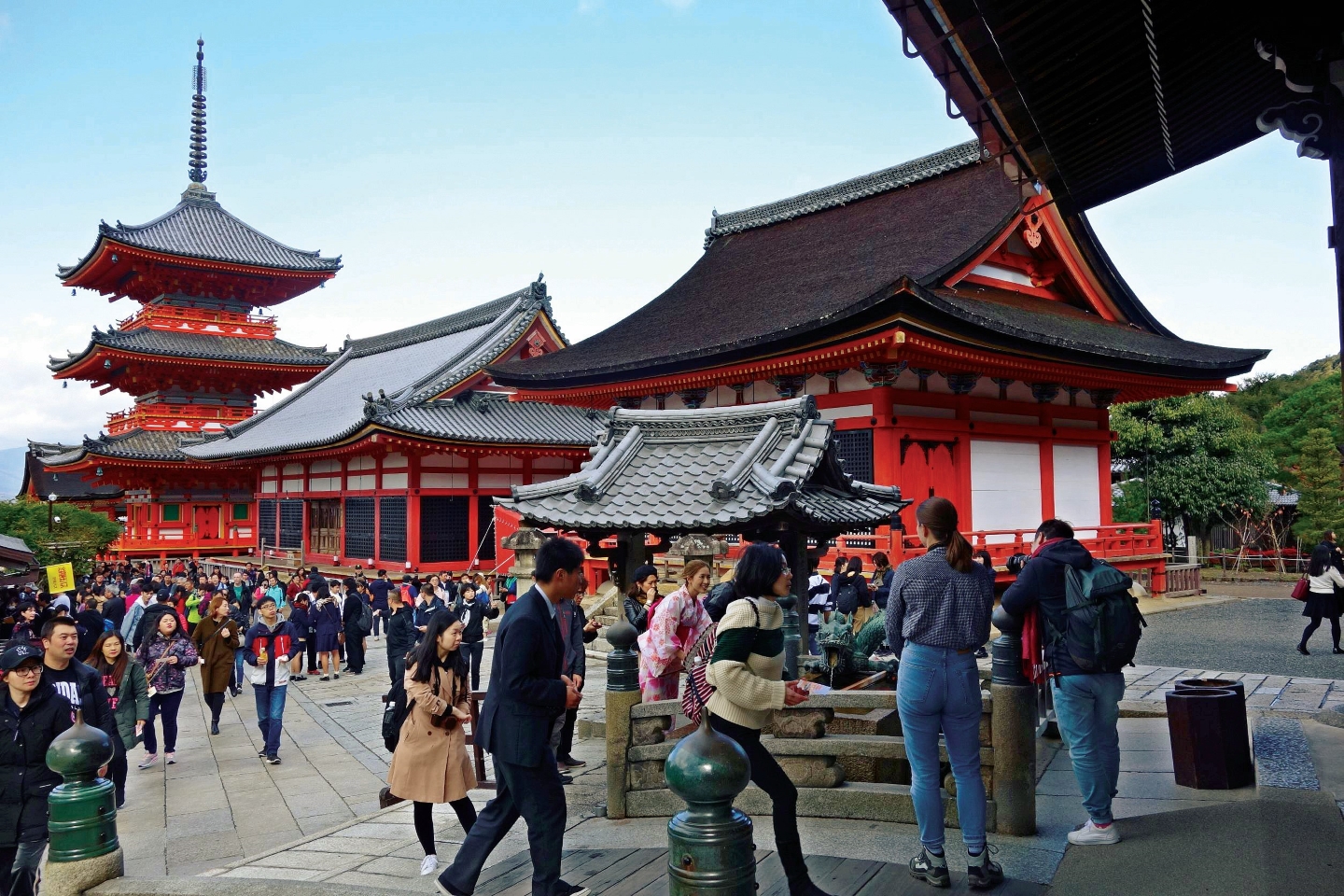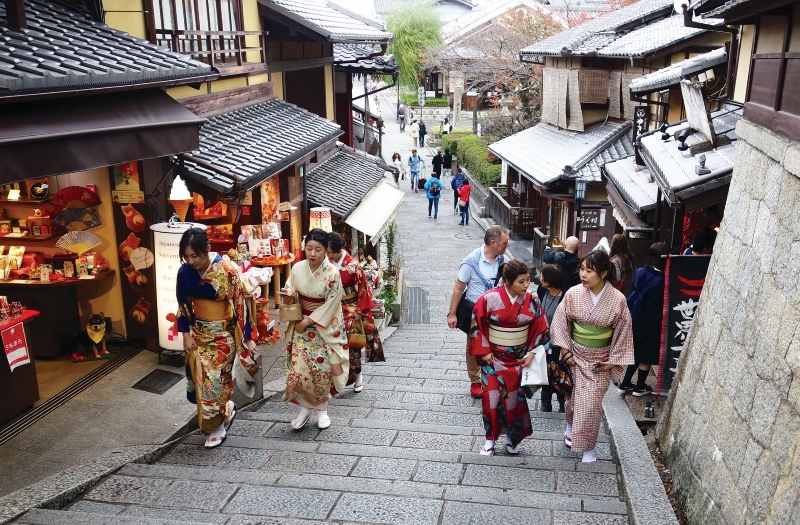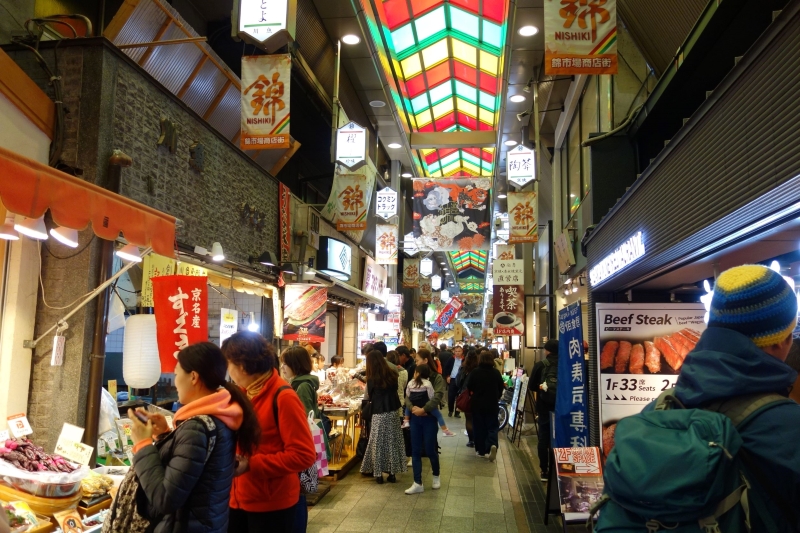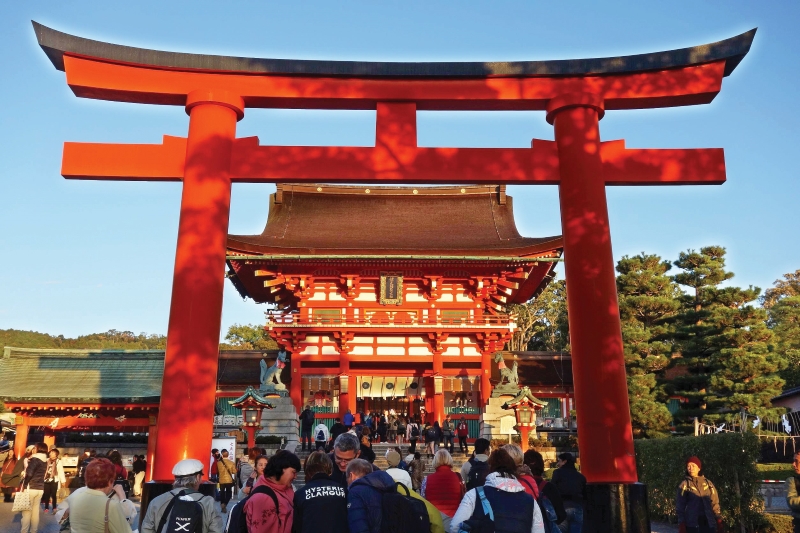
The morning crowd visiting the Kiyomizu-dera Temple, one of the most famous temples in Kyoto, which originated in 778AD (All photos: Lee Yu Kit)
There were shadowy shapes in dimly lit lanes and discreet signboards on buildings, with light filtering out from within. I didn’t see any geishas that evening in Gion, Kyoto’s famous geisha district, inhabited by high-end bars and restaurants housed in traditional wooden merchant houses, yet within these establishments, a craft quintessentially Japanese continues to thrive and beguile customers.
I hadn’t planned to be there. It was at the suggestion of the helpful officer at the tourist information booth, where I had stopped to ask where I could get some good Kyoto-speciality noodles.
It was one of many pleasant encounters with the city’s service staff, who seem immeasurably modest. More than once, I encountered knowledgeable station masters, phlegmatic looking men (I have never met a woman station master) manning the booth by the turnstiles, who were treasure troves of information.
This cultural modesty seemed uniform. I had similar experiences at Family Marts, department stores, shops, from staff who supposedly spoke no English, only to be given detailed instructions in more than passable English. This applied to passers-by as well, total strangers who literally went out of their way to show me my way.
This self-effacing attitude extends to services in general, to trains and buses that run with such clockwork accuracy that you can set your watch by them. It is a paradox that has flummoxed any foreigner who has spent time in Japan — how it can be so ultra-service-oriented and modern, and simultaneously anachronistic and courtly in an old-fashioned way. Cash is still used for most transactions, and in an expensive labour market, many services that can be automated are still manned. Goods are elaborately overpackaged, generating unnecessary waste, but streets are conspicuously litter-free and a garbage can is hard to come by.
cityscape.jpg

Yet ultra-polite Japanese society — uniform, well groomed and lubricated like the fluid movement of a smooth machine — breaks down suddenly and unexpectedly as in a vicious subway gas attack, in an unexplained fit of shocking random violence, in its strange underwear fetishes and graphically violent pornography, in the highest suicide rates in the world, and in the increasing social dysfunction of youthful singles who live alternative lives removed from the society they are part of.
Japanese culture, its expression and form, and its underlying values, are an enduring mystery. In the historic neighbourhoods of Kyoto, I encountered people dressed in traditional Japanese garb, invariably tourists who had visited a salon to be dressed in period costume, probably in the hope of capturing a little of the allure, if not the mystique, of a stubbornly opaque culture.
The area around the 8th century Japanese Buddhist Kiyomizu-dera temple, one of the most celebrated temples in Japan, was awash in the gay colours of kimonos and yukatas worn by visitors dressed for the occasion, and given fresh meaning in the age of selfies and Instagram.
Nearby, the historical pedestrian alleys of Ninen-zaka and Sannen-zaka districts looked particularly festive, with beautifully preserved and restored wooden buildings, complementing the kimonos worn by Filipinas, Taiwanese, Chinese, Malaysian and other female visitors. The windows of shops were filled with elaborate, tiny detailed things, whether it was crockery or clothing, or cutesy things like kitten dolls with large eyes and waving paws.
Kyoto is the quintessential Japanese cultural city, the capital of imperial Japan and the residence of the emperor from the 8th to 19th century before Tokyo became the capital of the country. With the long residency of the Imperial Court, many of the Japanese traditional arts and crafts originated and were refined here. It is the birthplace of Japanese cultural identity. The tea ceremony, flower arrangement, kabuki theatre, kaiseki cuisine and Noh theatre originated or were developed here. Kyoto has over 2,000 temples and 17 Unesco-listed World Heritage Sites.
streets.jpg

Traditional industries such as paper fans, ceramics, pottery, lacquerware, silk-weaving and incense continue to thrive in Kyoto. It saw widespread destruction in the internecine wars between rival factions in the 15th century. In World War II, it was a prime target for the atomic bombs that eventually fell on Hiroshima and Nagasaki. It escaped the Allied fire-bombing that consumed Tokyo and many other large Japanese cities during the war, where wooden buildings burnt like tinder, fuelling blazing conflagrations that razed many of these cities to the ground.
Kyoto survives as a time capsule, a living monument to Japanese culture and an open museum of an imperial Japan that seems lost to development and the sterilisation of modernisation. Japanese tradition and culture are cherished and very much alive in this modern, ancient society.
I found myself at the Choin-in temple, the main temple of a Japanese Buddhist sect. My head craned back to take in the heft and size of the colossal, wooden gates — the largest in Japan. More than its sheer size, its dark, brooding majesty, the flared arches and sweeping lines of the hip and gable roof conveyed loftiness of purpose and architectural refinement.
I walked up the flight of broad stone steps into the extensive, quiet compound of the main temple, with gardens and small shrines by the side, with a pool and arched stone bridgeway. The temple building was striking, not for its ornateness or decoration but for its lack of them. It was majestic in its austere proportions, grace and sombre dominant colours. It was shorn of unnecessary adornment, built not to please the masses but as if for a higher purpose.
When Buddhism permeated Japan in the 6th century, it was not immune to Japanese culture, belief system and way of life, resulting in a unique, syncretic form of the religion as it is practised today — contemplative, introspective and insistently interrogative.
teramachi.jpg

From the sublime and spiritual, I took the subway into the heart of Kyoto’s shopping district for the worship of a different kind, that of commerce and another aspect of Japanese city culture: mass-market consumerism.
The best-known shopping streets in Kyoto are Shinkyogoku and Teramachi, yet they couldn’t be more different. The former targets the young and restless with its colourful, kitsch, cheap, clever gadgets and garish fashion, while the latter caters to the wider demographic and the more affluent.
Centuries ago, there were many temples in the area, hence the name Teramachi, meaning “Temple Street”. Both streets are giant arcades, covered pedestrian walkways crammed with shops on either side, with side streets splitting off to more shops.
Teramachi street spans several roads, where traffic stops or comes to a crawl, to allow passage to the masses of people. From designer cosmetics to pharmacies, convenience stores, fast food outlets, ramen shops, fashionable boutiques and everything else in between, Teramachi offers bewildering choices to separate your yen from your wallet.
Yet this temple of modern consumerism encapsulates the traditional, the essentially Japanese, for there are shops, some of them centuries old, selling artisanal craft such as wood-block prints, hand-made paper, incense sticks and hand-crafted knives.
Enfolded in the colour and bustle of modern consumerism are several temples. One of them is Nishiki Tenmangu, a small, famous and exquisite Shinto shrine, with a torii gate straddling the busy shopping alley like a blessing. Many people, young and old, stop by the shrine, with its rows of lanterns. It is directly opposite the street of the centuries-old Nishiki Market, where over 100 stalls sell traditional provisions and food — pickles, tako balls, sweets, mochi, dried foods, skewers of wagyu beef, fresh seafood and a lot more.
fushimi.jpg

I browsed the shops, sampling their wares with the crowd pressing in, which would be rich hunting grounds for pick-pockets elsewhere, but Japan is well known for its safety and civic consciousness, of being reunited with your wallet if you accidentally leave it behind in the subway, a bus or a shop.
As the day waned, I made my way to one of the most spectacular shrines in Kyoto. It was old before Kyoto became the imperial capital in the 8th century. There are thousands of shrines throughout Japan dedicated to Inari, the Shinto god of rice, and this is the mothership of all Inari shrines.
The magnificent two-storey Romon gate led to the main shrine building, highlighted in gold, white and vermilion. Statues of foxes, messengers of Inari, were scattered throughout the temple grounds.
Behind the main shrine was a hiking trail, leading up the wooded, 233m Mount Inari. The main trail was framed by thousands and thousands of vermilion torii gates, donated by individuals and corporations, making for a surreal, modernist gateway, a sci-fi portal transporting the traveller to an alternate reality. This is called the Senbon Torii (thousands of torii gates).
In the dusk, I stood in the tunnel of receding vermilion frames, ancient and yet so strikingly modern, on the small hill overlooking Kyoto. Torii gates mark the transition from the corporeal to the spiritual, and it was a perfect metaphor for the seeming dichotomy of ancient, cultural Kyoto, existing in harmony with its modern, 21st century self.
This article first appeared on Nov 27, 2023 in The Edge Malaysia.


